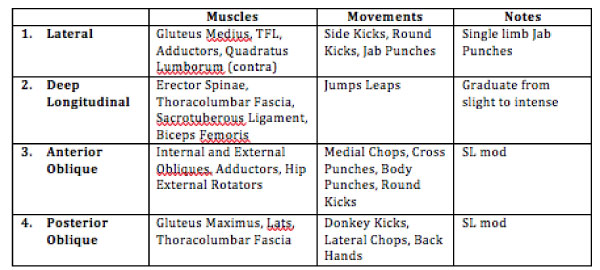The body naturally uses a system of muscles to perform most everyday movements. For example, when getting out of bed, in order to perform that task, it’s required that the abdominal obliques work in concert with the hip adductor complex in order to complete this movement. (This is an oversimplification for illustration purposes).
Knowing the body’s movement patterns and synergies and then applying focused training allows the patient to move better with more accuracy, good form, and prepares them to properly adjust to the unpredictable forces during life, work and play.
There are 2 distinct yet interdependent systems that enable our bodies to distribute forces efficiently (according to Bergmark)1.
The 2 systems are Local and Global Musculature.
The Local musculature comprises muscles that primarily support and stabilize the spine. They do not perform gross movement but rather offer stability during joint motion. Such as transverse abdominis, multifidus, and pelvic floor.
The Global musculature system performs gross trunk and extremity movements. These are the superficial muscles such as the rectus abdominis, latissimus dorsi, and external obliques.
Proper activation and recruitment of both systems is required for optimal movement and performance.
For the purposes of our MFM training, we will focus more on the Global system.
The 4 Subsystems
There are 4 common muscle synergies within the Global system:
- Lateral
- Longitudinal (“Deep Longitudinal)
- Anterior Oblique
- Posterior Oblique
Lateral subsystem is made up of:
- Gluteus medius
- TFL
- Adductor complex
- Contralateral Quadratus Lumborum
Examples: Side-Kicks, Round Kicks, Jab Punches (mod)
It’s is responsible for frontal plane stability, pelvo-femoral stability during single-leg movements such as gait, lunges, and stair climbing. Dysfunction in this lateral system results in excessive pronation of the knee, hip and feet during gait and exercise. You may see excess genu valgum during squat or gait.
Deep Longitudinal subsystem is made up of:
- Erector Spinae
- Thoracolumbar fascia
- Sacrotuberous Ligament
- Biceps Femoris
Examples: Leaps and Jumps
It’s responsible for stabilizing the body from the ground up. Absorbing the forces transmitted longitudinally from the foot and ankle to the trunk and back down. It controls the ground reaction forces during gait.
Anterior Oblique subsystem is made up of:
- Internal Obliques
- External Obliques
- Adductor Complex
- Hip External Rotators
Examples: Medial Chops, Cross Punches, Body Punches, Round Kicks.
It’s responsible for both pelvis rotational and flexion movements in the transverse plane and stabilizing the lumbo-pelvic-hip complex. Works in concert with the Posterior Oblique subsystem.
Posterior Oblique subsystem is made up of:
- Gluteus Maximus
- Latissimus Dorsi
- Thoracolumbar fascia
Examples: Donkey Kicks, Lateral Chops, Back Hands
It’s responsible for stabilizing the SI joint during rotational activities. When the gluteus maximus and contralateral latissimus dorsi contract, they create a stabilizing force for the SIJ. It works in concert with the deep longitudinal system to distribute forces efficiently.
In addition, the PO subsystem transfers forces form the transverse plane into propulsion when we walk or run (in the sagittal plane). The PO subsystem is essential for rotational activities such as swinging a golf club, baseball bat, and throwing. The weakening of the gluteus maximus and/or lats may lead to increased tension in the hamstrings leading to injury.
Looking forward to seeing you soon!


